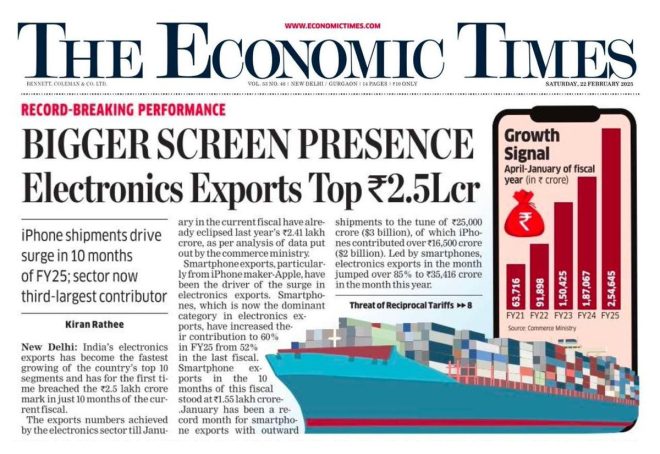
Electronics Exports Surge Post-PLI in FY25
In a remarkable achievement for India’s electronics sector, electronics exports have reached unprecedented levels in the fiscal year 2025, showcasing the significant impact of the Production-Linked Incentive (PLI) scheme. According to a recent tweet by Union Minister Ashwini Vaishnaw, electronics exports have crossed ₹2.5 lakh crore within just ten months of FY25, marking a substantial increase in India’s position in the global electronics market.
Record-Breaking Electronics Exports
The figures reveal that out of the total electronics exports, a staggering ₹1.5 lakh crore comes specifically from smartphones, setting a new benchmark in the industry. This increase in smartphone exports underscores the growing demand for Indian-made electronics, both domestically and internationally. The current run rate indicates a 36% increase compared to FY24, reinforcing the notion that electronics exports are becoming the fastest-growing segment in India’s export portfolio.
The Impact of the Production-Linked Incentive (PLI) Scheme
The PLI scheme, introduced by the Indian government, aims to boost domestic manufacturing and attract global companies to invest in India. By providing financial incentives for manufacturing certain electronics, the scheme has played a pivotal role in enhancing production capabilities and scaling up exports. The impressive growth in electronics exports can largely be attributed to this strategic policy, which encourages firms to manufacture high-value products in India.
Growth in Smartphone Exports
Smartphones have emerged as a key driver of the export growth, with Indian manufacturers ramping up production to meet both local and international demands. The government’s efforts to promote local manufacturing have led to collaborations with global tech giants, thereby enhancing the quality and competitiveness of Indian electronics in the global market. The growing consumer base, coupled with rising disposable incomes, has fueled the demand for smartphones, making India a formidable player in the global electronics landscape.
- YOU MAY ALSO LIKE TO WATCH THIS TRENDING STORY ON YOUTUBE. Waverly Hills Hospital's Horror Story: The Most Haunted Room 502
Future Prospects for Electronics Exports
Looking ahead, the outlook for electronics exports in India appears promising. With the government’s continued focus on improving infrastructure, streamlining regulations, and enhancing skill development, the electronics sector is poised for sustained growth. The PLI scheme is expected to further evolve, attracting more foreign direct investment and encouraging innovation within the industry.
The ongoing digital transformation and the rise of the Internet of Things (IoT) also present new opportunities for Indian electronics manufacturers. As global demand for smart devices and connected technologies continues to rise, India is well-positioned to capitalize on these trends.
Conclusion
In summary, the record-breaking figures of electronics exports in FY25 highlight the success of the PLI scheme and the increasing prominence of India in the global electronics market. With smartphones leading the charge, the sector is witnessing unprecedented growth, positioning India as a key player in the global electronics supply chain. As the government continues to support this growth trajectory, the future of electronics exports in India looks exceptionally bright.
This remarkable development is not only a testament to the resilience and innovation of Indian manufacturers but also a reflection of the country’s strategic initiatives aimed at making India a global electronics hub. The sustained growth in this sector will likely contribute to economic development, job creation, and enhanced global competitiveness in the years to come.

Electronics exports reach record-breaking numbers post-PLI yet again
Electronics exports cross ₹2.5 lakh crore within 10 months of FY25, with ₹1.5 lakh crore from smartphones—the highest ever.
Run rate is 36% higher than FY24—electronics is the fastest-growing export in… pic.twitter.com/EVwSeTwPMq— Ashwini Vaishnaw (@AshwiniVaishnaw) February 22, 2025
Electronics Exports Reach Record-Breaking Numbers Post-PLI Yet Again
Electronics exports in India are soaring to unprecedented heights, showcasing the country’s growing prowess in this critical sector. As of February 2025, electronics exports have crossed an impressive ₹2.5 lakh crore within just ten months of FY25. The surge is largely driven by smartphones, which alone account for ₹1.5 lakh crore—marking the highest ever recorded for this segment. The growth trajectory is remarkable, with a run rate that is 36% higher than FY24. Clearly, electronics is becoming the fastest-growing export category for India.
This explosive growth in electronics exports reflects the substantial impact of the Production Linked Incentive (PLI) scheme, which has incentivized manufacturers to ramp up production and exports. In this article, we’ll dive deeper into the factors contributing to this boom, the implications for the Indian economy, and what we can expect moving forward.
Understanding the PLI Scheme and Its Impact
The Production Linked Incentive (PLI) scheme was introduced by the Indian government to boost domestic manufacturing and attract foreign investment. Under this initiative, companies receive financial incentives based on their incremental sales from goods manufactured in India. It’s a win-win situation: manufacturers get a financial boost, while the country benefits from increased exports and job creation.
The success of the PLI scheme is evident in the record-breaking numbers for electronics exports. The smartphone sector, in particular, has seen a remarkable uptick, with several global brands setting up manufacturing bases in India. This not only enhances local production capabilities but also strengthens India’s position in the global supply chain. Companies like Apple and Samsung have ramped up their operations, contributing significantly to the export figures.
Smartphones Leading the Charge
When we look at the specifics, the smartphone segment stands out as a major contributor to the overall electronics export figures. The ₹1.5 lakh crore generated from smartphones is no small feat and underscores the growing demand for Indian-made electronic devices. The shift towards online learning and remote work during the pandemic has further fueled this demand, as consumers look for reliable and affordable technology.
Moreover, Indian manufacturers are increasingly focusing on quality and innovation, which is crucial for competing in the global market. With a diverse range of products and competitive pricing, Indian smartphones are gaining popularity not just domestically but also internationally. The success of brands like Xiaomi, Vivo, and OnePlus in export markets highlights this trend.
Factors Driving Export Growth
Several factors are driving the growth of electronics exports in India. Let’s take a closer look at some of the key drivers:
1. **Government Support:** The Indian government has implemented various policies to facilitate manufacturing and exports. This includes not just the PLI scheme but also initiatives aimed at improving infrastructure, reducing import duties on components, and simplifying regulatory processes.
2. **Rising Domestic Demand:** With a burgeoning middle class and increasing smartphone penetration, there’s a significant domestic market for electronics. This has encouraged manufacturers to scale up production, which in turn boosts exports.
3. **Global Supply Chain Shifts:** The COVID-19 pandemic has prompted companies worldwide to rethink their supply chains. India is becoming an attractive alternative for companies looking to diversify their manufacturing bases away from China.
4. **Technological Advancements:** Innovations in technology and manufacturing processes are making it easier for Indian companies to produce high-quality electronics. This is particularly true in sectors like semiconductors, where investments are ramping up.
Electronics: The Fastest-Growing Export Sector
The record-breaking figures in electronics exports highlight the sector’s potential as the fastest-growing export category in India. This is not just a numbers game; it signifies a shift in the global landscape of technology and manufacturing.
With a robust ecosystem of manufacturers, suppliers, and a skilled workforce, India is poised to become a key player in the global electronics market. The government’s focus on enhancing the ease of doing business, along with strategic partnerships with global tech firms, is paving the way for sustained growth in this sector.
Future Prospects and Challenges
While the outlook for electronics exports is bright, there are challenges that need to be addressed. The global semiconductor shortage is one such issue that could impact production timelines. Additionally, maintaining quality and competitiveness in pricing will be crucial as more players enter the market.
To sustain this momentum, it is essential for the Indian government to continue supporting the industry through favorable policies and investment in infrastructure. Collaboration between the government and private sector will be vital in navigating the challenges ahead.
Moreover, as global demand for electronics continues to rise, Indian manufacturers will need to innovate and adapt. This means investing in research and development, improving supply chain efficiencies, and embracing sustainability practices.
The Economic Ripple Effect
The surge in electronics exports is not just beneficial for manufacturers; it has a positive ripple effect on the broader economy. Increased exports lead to higher revenue for the government, which can be reinvested into public services and infrastructure. Moreover, as companies expand their operations, job creation becomes a natural outcome, contributing to overall economic growth.
With the electronics sector becoming a significant driver of India’s export economy, it’s an exciting time for the country. The potential for growth is immense, and with the right strategies in place, India can solidify its position as a global leader in electronics manufacturing.
Conclusion: A Bright Future for Electronics Exports
The record figures in electronics exports post-PLI are a testament to India’s growing capabilities in this vital sector. With a focus on quality, innovation, and government support, the future looks promising. As we witness this transformation, it will be interesting to see how India continues to evolve in the global electronics landscape.
For more insights into India’s booming electronics exports, you can check out [Ashwini Vaishnaw’s tweet](https://twitter.com/AshwiniVaishnaw/status/1893227841971716267?ref_src=twsrc%5Etfw) and explore the ongoing developments that are shaping this dynamic industry.
